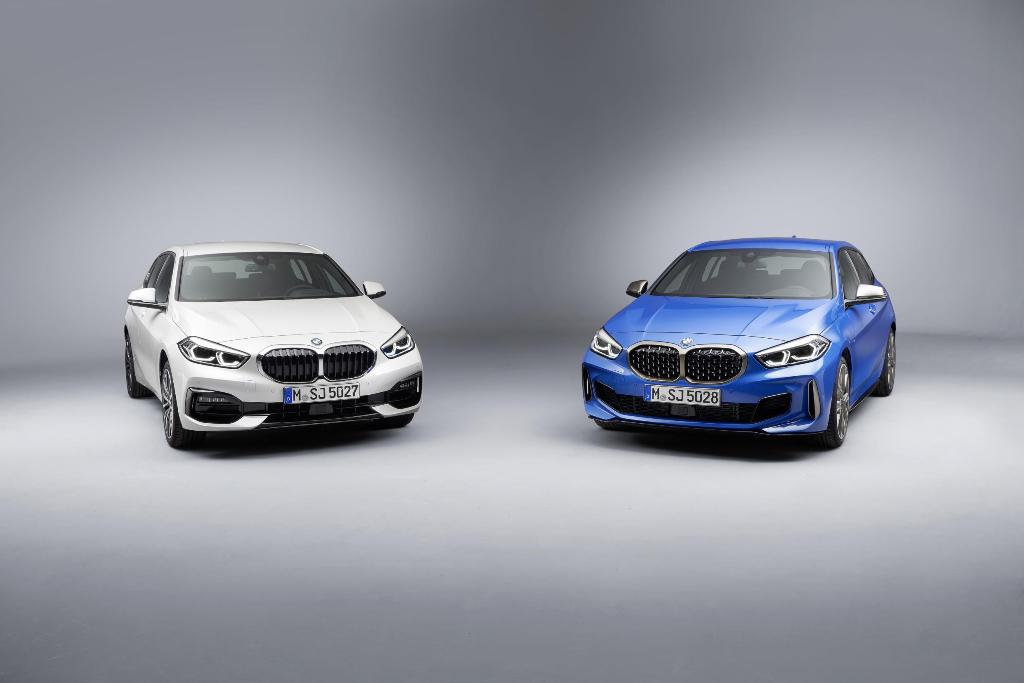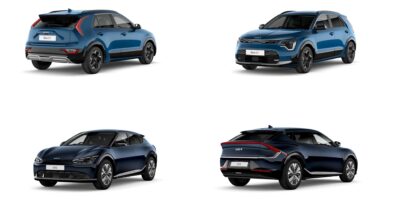The arrival of the all-new BMW 1 Series heralds the dawn of a new era for this successful model that has consistently combined handling excellence, practicality, technology and quality.
Now in its third generation, the BMW 1 Series features a dynamic design, roomier interior, a raft of cutting-edge technologies as well as BMW’s trademark agility and superior performance.
It features a shorter bonnet and significantly more space within a footprint almost identical to that of its predecessor. At 4,319 millimetres, the new BMW 1 Series is five millimetres shorter, 34 millimetres wider and 13 millimetres higher. At 2,670 millimetres, the wheelbase is 20 millimetres shorter.
There have been a number of design changes including a new headlight arrangement, a more wedged shaped silhouette and a pronounced ‘shark nose’. At the front, the BMW kidney grille is larger and, for the first time in this model range, the kidneys merge in the middle. The range-topping BMW M135i xDrive features a distinctive grille with a mesh design instead of the classical bars.
Viewed from the side, the BMW 1 Series features a distinctive window graphic enhanced by two character lines. One runs below the door handles from the front wheels to the rear wings, while the other starts in the lower part of the front door before lifting towards the rear quarter. In addition, the greenhouse is elongated with the traditional Hofmeister Kink incorporated into the C pillar.
Increased interior and boot space
The front-wheel-drive architecture with transverse engines and a lower centre tunnel offers the occupants more space than in the predecessor. This applies especially to those in the rear seats. Access is easier and there is an extra 33 millimetres of kneeroom available. Rear headroom is up by 19 millimetres when the outward opening panoramic sunroof is fitted. Rear passengers also enjoy 13 millimetres more elbowroom, while the driver and front passenger get extra 42 millimetres in this respect. Luggage compartment capacity rises by 20 litres to 380 litres (1,200 litres with the rear seat bench folded down). The minimum width of the luggage compartment has also increased by 67 millimetres. An electrically operated tailgate is now optionally available for the BMW 1 Series for the first time.
Driver-oriented cockpit
Situated immediately in front of the driver is the instrument cluster along with the accompanying central Control Display. Designed for touch operation, it is oriented towards the driver and positioned optimally in their field of view. The controls for the heating, air conditioning and new hexagonal air vents are grouped together in the centre console below the Control Display. With the Start/Stop button and gear selector lever now also located in the control panel in the lower section of the centre console, all the controls relating to driving functions are clustered together in one area. This includes the iDrive Touch Controller used to control the infotainment system. In front of the selector lever is a storage area which can be specified with the Wireless Charging option for smartphones.
The interior has more space and features high-quality materials throughout, driver-focused controls and innovative details, such as backlit trim strips. The BMW 1 Series with optional BMW Live Cockpit Professional features the new BMW Operating System 7.0 – with optional gesture control – which can be controlled via 10.25 inch screen.
New light-alloy wheels up to 19 inchesÂ
The new BMW 1 Series is available with a wide range of new light-alloy wheels, including – for the first time – the option of wheels with a diameter of 19 inches. The SE model has 16-inch light-alloy wheels as standard. The Sport models feature 17-inch light-alloy wheels whilst the M Sport moves up to 18-inch light-alloy wheels as standard. The BMW M135i xDrive comes with bespoke polished 18-inch light-alloys, whilst newly designed 19-inch light-alloy wheels are optionally available for this and the M Sport model.
Panoramic roof available as an optionÂ
For the first time a panoramic roof is available as an option for the BMW 1 Series. With a 0.7m glass area, the roof features an electrically operated roller blind to provide shading along with a net wind deflector to reduce noise when open.
Three equipment lines and one flagship modelÂ
The BMW 1 Series offers SE, Sport and M Sport trims as well as the range-topping M135i xDrive, all of which differ from one another in both exterior and interior details. SE comes with matt black air guide grilles on the front bumper, while Sport adds exclusive air inlets finished with a high-gloss black, the kidney grille features a chrome frame with high-gloss black struts. The M Sport features aerodynamic bodystyling as well as satin aluminium struts in the kidney grille whilst the seat upholstery is in Dakota leather with contrast stitching. The range-topping BMW M135i xDrive incorporates the mesh-design BMW kidney grille and frame, exclusive front bumper air inlet clasps, and wing mirrors all finished in Cerium Grey. Exclusive black high-gloss rear diffuser with mesh design, and side sill covers featuring exclusive M135i xDrive black high-gloss inserts complete the look. Inside there’s the M Sport seat with integrated headrest design finished in Trigon Cloth/Alcantara Anthracite upholstery.
Transfer of technology from the BMW i3sÂ
The new BMW 1 Series features the actuator contiguous wheel slip limitation (ARB) technology used in the BMW i3s. This is the first time it has been used in a combustion-engine car and it has the effect of significantly improving traction when pulling away, cornering or when driving in the wet. The system works in close tandem with the DSC system to significantly reduce power understeer.
ARB is assisted in its task by BMW Performance Control (yaw moment distribution). This feature, which is also included as standard on the BMW 1 Series, gives it more agile handling by intelligently applying the brakes at the wheels on the inside of the bend. This suppresses any initial understeer and gives the car neutral steering behaviour. Alternatively, drivers can engage the DSC system’s propulsion-optimised Dynamic Traction Control (DTC) setting, which allows a greater degree of slip at the driven wheels and thereby paving the way for a ‘sportier’ driving style.
Two models with BMW xDrive intelligent all-wheel drive
ARB technology and BMW Performance Control also feature on the BMW 120d xDrive and the BMW M135i xDrive, which are both equipped with BMW xDrive intelligent all-wheel drive as standard. This can split drive power 50:50 if necessary and is designed to ensure predictable handling in all driving situations. This applies even if the Driving Experience Control switch is set to Sport mode, DTC is selected or DSC is deactivated.
In Comfort or Eco Pro mode, drive is split as required, while keeping fuel consumption as low as possible. Fuel economy is therefore improved without any discernible impact on driving dynamics or traction. As well as the all-wheel-drive system, standard specification for the BMW M135i xDrive includes a newly developed mechanical Torsen limited-slip differential, which gives the car an even sportier edge.
The differential is integrated into the standard eight-speed Steptronic Sport transmission on the BMW M135i xDrive and also features a Launch Control mode that puts the full peak torque of 450Nm on tap in first and second gear.
Increased body rigidityÂ
Making intelligent use of aluminium – for the bonnet and tailgate for instance – combined with high-strength steels, has enabled BMW to shave as much as 30 kilograms off the weight of the new BMW 1 Series compared to its predecessor, at the same time as further increasing the torsional stiffness of the body structure.
BMW M135i xDrive – superior handling and braking capability
The positive dynamic impact of the rigid body is even more pronounced on the ultra-sporty, range-topping BMW M135i xDrive that features a number of chassis improvements to improve handling and ride quality. This all combines with the standard M Sport suspension and the M Sport steering with its more direct ratio and even sharper response. Meanwhile, the M Sport brakes offer excellent stopping power at all times. The M Sport steering and M Sport brakes are also available for M Sport models in the M Sport Plus package.
Three suspension options
Besides the standard suspension and the M Sport suspension with 10mm reduction in ride height, the new BMW 1 Series can also be specified with the Adaptive suspension including VDC (Variable Damper Control) as an option (not available in conjunction with 19-inch alloy wheels). This lets the driver choose from two different damping response settings via the Driving Experience Control switch, namely Comfort – for better ride comfort in poor road conditions – or Sport for a very sporty drive.
Engine line-up
The all-new BMW 1 Series is powered by three-cylinder and four-cylinder engines with a choice of three diesel and two petrol engines at launch. Improvement in the power units’ efficiency have resulted in higher real-world fuel economy and lower exhaust emissions. Performance characteristics have likewise been enhanced and, in some cases, output has been increased too. The line-up is spearheaded by the newly developed power unit for the BMW M135i xDrive, the BMW Group’s most powerful four-cylinder engine.
| Model | Power output (hp) |
Peak Torque (Nm) |
Acceleration (zero to 62mph) |
Top Speed (mph) |
Fuel consumption (mpg) WLTP |
COÂ 2emissions (g/km) NEDC* |
OTR Price from |
| 118i | 140 | 220 | 8.5 | 132 | 47.1 – 40.4 | 123-114 | £24,430 |
| M135i xDrive | 306 | 450 | 4.8 | 155 | 35.3 – 34.4 | 157-155 | £36,430 |
| 116d | 116 | 270 | 10.3/10.1 | 124 | 61.4 – 54.3 | 103-100 | £25,480 |
| 118d | 150 | 350 | 8.5/8.4 | 135/134 | 60.1 – 51.4 | 111-108 | £26,640 |
| 120d xDrive Sport | 190 | 400 | 7.0 | 143 | 51.4 – 48.7 | 119-117 | £32,470 |








